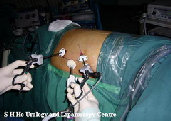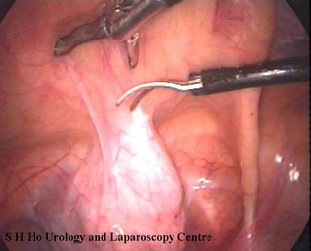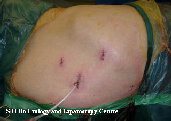MBBS, FRCS, FICS, FAMS (Urology)
Senior Consultant & Board Certified Urologist (Singapore)
Gleneagles Medical Centre #09-18, Singapore 258499
Tel: +65 647 52512
S H HO UROLOGY AND LAPAROSCOPY CENTRE
Cutting Edge Urology Care with Compassion
Laparoscopy Surgery in Urology
Common Conditions
Laparoscopic surgery, also called minimally invasive surgery (MIS), keyhole surgery, or pinhole surgery is a modern surgical technique
in which operations in the abdomen are performed through small incisions (usually 0.5-1.5cm)
The key element in laparoscopic
surgery is the use of a laparoscope: a telescopic rod lens system that is usually connected to a video camera. Also attached is a
fiber optic cable system connected to a light source to illuminate the operative field. The abdomen is usually insufflated with carbon
dioxide gas to create a working and viewing space. The gas used is CO2, as it is common to the human body and can be removed by the
respiratory system if it absorbs through tissue.
Urology Procedures
Laser Surgery
Opening Hours:
Monday - Friday
9am to 5pm
Saturday
9 am to 1 pm
Sun / Public Holiday
Closed


External view of laparoscopy surgery and instruments

Internal view of laparoscopy surgery and instruments
Small surgical wound size after laparoscopy surgery
There are a number of advantages to the patient with laparoscopic surgery versus an open procedure. These include:
* reduced
blood loss, less risk of needing a blood transfusion.
* smaller incision, less pain and shorter recovery time.
* less pain, less pain medication needed.
* reduced exposure of internal organs to possible external contaminants thereby reduced risk of acquiring infections.
* smaller incision, less pain and shorter recovery time.
* less pain, less pain medication needed.
* reduced exposure of internal organs to possible external contaminants thereby reduced risk of acquiring infections.
Our centre specializes in various techniques of laparoscopy surgery for urological conditions. Dr Ho is one of the leading laparoscopic urology surgeons in Singapore since 2001. He has conducted many workshops and lectures in this area.
Laparoscopy Surgery at Urology Centre
Laparoscopy Kidney Surgery
Laparoscopy Prostate Surgery
Laparoscopic radical nephrectomy for kidney cancer. The entire kidney is removed as a cure for kidney cancer. Kidneys that are not
functioning and infected can also be removed with this technique.
Laparoscopic partial nephrectomy for smaller kidney cancer
and preservation of kidney function is desired. Only a portion of the kidney is removed and the area is repaired by laparoscopic placement
of sutures.
Laparoscopic nephroureterectomy for transitional cell cancer of the kidney or ureter. The entire kidney and
ureter (urine tube joining kidney to bladder) is removed as cure for transitional cell cancer.
Laparoscopic marsupialization
of kidney cyst for a large and obstructing kidney cyst. Fluid from the kidney cyst is aspirated and the cyst is decompressed
before complete removal.
Laparoscopic pyeloplasty for pelvic ureteric junction obstruction. This is usually done for congenital
or inóborn obstruction at the junction between the kidney and ureter.
Laparoscopic radical prostatectomy by the extra peritoneal approach for early prostate cancer. The entire prostate gland is removed
as a cure for prostate cancer.
Laparoscopy Hernia Surgery
Laparoscopic hernia repair or hernniorraphy for inguinal and recurrent hernia. We use the total extra peritoneal approach to
completely mimic open surgery with advantages of laparoscopy.
Laparoscopy Varicocele Surgery
Laparoscopic varicocelectomy for varicoceles causing pain or subfertility in male. Especially advantageous in patients with two sided
varicocele where surgery on both sides can be done with similar set of incisions.
Laparoscopy Adrenal Surgery
Laparoscopic adrenalectomy for adrenal gland tumor or growth. The entire adrenal gland is removed either due to adrenal cancer or
a growth that is causing hormonal disturbance such as Cushing syndrome, hypertension or hyperaldosteronism.
Other Laparoscopy Urology Surgeries
Laparoscopic ureterolithotomy for large ureter stone. Very large ureter stone that is causing obstruction can be removed completely
with a single step.
Laparoscopic reimplantation of ureter for ureter stricture or injury. Ends of the narrowed or injured ureter
are reattached to the bladder in order to restore continuity of urine flow.
Laparoscopic augmentation cystoplasty for small and
contracted bladder. A segment of small intestine is used to increase the size of the diseased bladder.
Make an appointment by email or Call us at +65 647 52512
